Team:XMU-China/Block6
From 2011.igem.org
| You can write a background of your team here. Give us a background of your team, the members, etc. Or tell us more about something of your choosing. | |
|
Tell us more about your project. Give us background. Use this is the abstract of your project. Be descriptive but concise (1-2 paragraphs) | |
| Team Example |
| Home | Team | Official Team Profile | Project | Parts Submitted to the Registry | Modeling | Notebook | Safety | Attributions |
|---|
Contents |
Overall project
Since three chemists from the U.S. won the Nobel Prize in 2008 for the discovery and development of green fluorescent protein (GFP), visualization of bioprocess has been studied and utilized more intensively than ever before. Our project is to design a visualization system in E.coli which can detect different substances and give out different visualized image respectively by producing GFP. This system is based on a complex genetic circuit. A Genetic circuit is a new type of bionetwork within which the parts in one cell or different cells work as standard parts in an electrical circuit. It can be designed for different functions and usually the more parts are involved, the more convoluted the network is, and the harder it is to be designed.
Project Details
Part 2
Although this area is pretty new to us, we have successfully built up the framework and logic formula for the circuit. Our genetic circuit is mainly made up of a group of promoters, inducers, repressors and report sequences. They are designed to function as a “monitor”, a device which can detect the existence of some substances and give out visualized signals by the cells. However, to finally make the circuit work as we supposed, there is still a long way to go. As a lot of promoters are involved, the circuit gets more convoluted than we thought. We have to find out appropriate substances and promoters which can interact with each other as well as meet the logic formula. We are now searching for different kinds of promoters which are available in the standard biobrick list and designing combinatorial promoters to fit the circuit. Meanwhile, there are some other factors like the time-delay between two genetic parts and the stability of the device which need to be considered. We are not clear whether we can finally overcome all these difficulties, but we are clear that this project is worth doing and everything worth doing is worth doing well. We will keep updating our experiment data and more details.
 "
"

